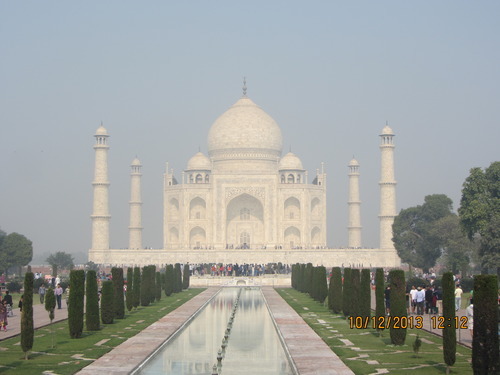Chor Bazaar
This Sunday we decided to go to old Delhi. After lunch, we took the metro from Dwarka Sec 10, got off at Rajiv Chowk for the yellow line and reached Chandni Chowk around 3. From the station, we took a Rick for Chor Bazaar (30 bucks).
The last time I went to Chor Bazaar was in ‘92. Those days, it was held in the ground in front of Red Fort. It was full of clothes, shoes, books as well as a lot of quirky stuff. You could find old records, gramophones, electronics, antiques, etc. I still remember one old man selling odds and end, including an earthquake intensity measuring equipment.
But in the early 2000s, the venue was shifted further from the Fort, on to the road, probably due to security considerations. In addition, the available space has now been squeezed from behind due to the metro construction. So, it is now a narrow strip, with the metro barricade behind, and a crowded bustling road in front.
**Warning** Once you enter The Strip, be prepared to be pushed, squeezed, jostled, stamped and if you are a lady, groped.
The bazaar is held every sunday. The place is full of clothes, jackets, jeans, suits( yes, formal suits), woollens, blankets, formal shoes, trekking shoes, woodlands, etc.
But no quirky or interesting stuff anymore.



[Don’t miss the Tommy Hilfiger briefs.]
The joy of going to flea market or Chor Bazaar is in leisurely wandering around, hoping to find that one thing you have been searching for, and get it for a steal (pun intended). Or for some, finding that one thing which you never thought of, never needed, have no use for, but still want to buy, the moment you set eyes on it, because it is so quirky and cheap.
Well, all that is no longer possible. The market is probably just reflecting the taste of the general public. Most people nowadays just want to buy clothes and shoes at a bargain - the lower income group in Chor bazaar, middle income group in Big Bazaar and the high income group in Marks & Spencers. All of us, irrespective of how rich we are, are looking for that special sale or great bargain. I guess, the person who may buy an earthquake measuring equipment no longer frequents these bazaars and is just not relevant in the economics of scale any longer.
The only interesting item I saw was a guy selling fish in a bottle…. Filled with yellow colored water and a red flower, for good measure.

After wandering around for some time, we decided to leave as there was nothing interesting.
Red Fort
So we moved on to Red Fort. Again, it was crowded.

There was a long line for tickets, but found a shorter one for ladies on the other side. Lavanya bought the tickets for us. Rs.15 per adult, children upto age 15 free.
***Boring / Interesting History***
[People are either fascinated or bored to death by history. I belong to the former. I never cease to wonder at how today’s India is so different from its past, but is so strongly shaped by it. You can just skip this part if it does not interest you.]
The Red Fort derives its name from the extensive use of red sandstone on the massive walls that surround the fort. Shah Jahan commissioned the construction of the Red Fort in 1638 when he decided to shift his capital from Agra to Delhi. Construction of the fort was completed in 1648. The Red Fort was originally referred to as “Qila-i-Mubarak” (the blessed fort), because it was the residence of the royal family. Unlike the other Mughal forts, layout of the boundary walls of the Red Fort is not symmetrical so as to retain and integrate the older Salimgarh Fort. The Yamuna once flowed along the walls and fed the moats that surround most of the fort wall. It is now 2 km away.
****The End of History as we know it…for now*******
Lahori Gate
There are two main gates leading into the fort. The first is Lahori Gate (leading to Lahore, obviously) and the second, Delhi Gate (Duh). The Delhi gate faced the old Old Delhi while the Lahori Gate faced Chandni Chowk, the Mall Road of Shahjahanabad (now Old Delhi). A third gate, supposedly called Yamuna gate, led to the river, from where the Royal entourage could go by boat to Agra.
****Just an Aside****
Chandni Chowk was designed by Jahanara, Shah Jahan’s daughter, in 1650. It was apparently one of the most beautiful avenues, ever. Foreign visitors describe it as a broad tree lined avenue with clear water flowing through the middle in a canal. There were designer shops on either side. It was named Chandni Chowk after the reflection of moonlight in the water in the canal. Today the 1.4 km stretch of road has a major Mosque, Gurudwara, Hindu Temple, Jain Temple and a Church. The Fatehpuri Mosque, Sis Ganj Gurudwara and Digambar Jain temple are around 350 years old, while the hindu temple is 250 years old and the church is a recent construction - just 200 years old. Where in the world can you find such a heritage?
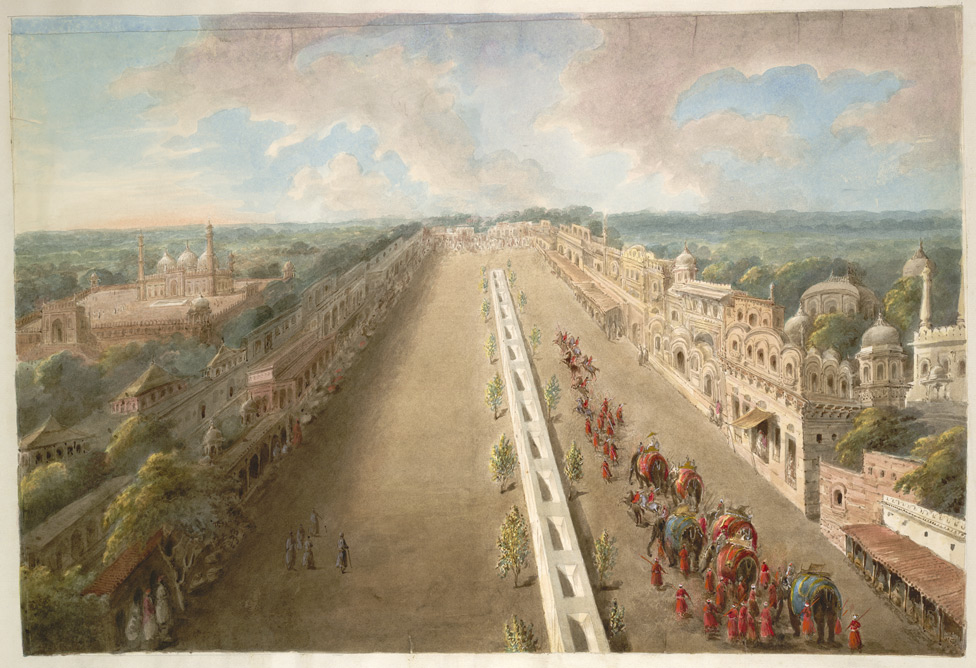
[View of Chandni Chowk from Lahori Gate, circa 1814-15]
*********************************************************************
We entered the fort through the Lahori Gate, which is the main entrance nowadays. There was a long line, but it moved swiftly. Basically for a normal airport style frisk.
The Independence Day speech by the Prime Minister is given from the ramparts of this gate.


Chatta Chowk
As in most Forts, there was a 90 degree turn as soon as you entered, ostensibly to deny elephants/ battering rams a run up to hit the inner gate. On entering the inner gate, there is a market called the Chatta Chowk or Meena Bazaar. Set up by Jahanara, it was the Harrods of it’s day.

Today, it is a series of small shops selling trinkets, marble figurines and other items of tourist interest. Spoke to a few of the shop keepers. Some have been there for over a 100 years….. and still pay Rs 16 per year as maintenance charges for the premises.
***Mundane Musings***
We took a guide to show us around for Rs 100. I believe, a guide should always be taken when you visit for the first time. He will know the best places to see, how to avoid the crowd and of course a good guide livens up the old dilapidated buildings (as they invariably are in India) with interesting stories attached to them. Some, you can read in guidebooks and internet as they are believed to be true, others you will never hear about as they are part of the storytelling and oral tradition. How much historical truth are there in these stories - your guess is as good as mine. Having a guide with us also highlighted the other age old Indian tradition - of being spectators. See anything happening on the street - an altercation, a fight, an accident, a street show, film shooting - and there will be a big crowd gathered around, doing absolutely nothing, just watching. Don’t think that this is a recent phenomenon. I have read accounts of early British archeologists, and have read references to similar behavior by locals wherever they have dug. So, here too, a crowd would gather around the guide telling the story. The guide would ask them if they would pay and they would give him a blank look or a vacuous smile. In case of him asking somebody repeatedly, he would slowly walk away. The best was a woman who walked in, pushed me aside and stood right in front of the guide. The guide, dripping with sarcasm, asked her if she would at least let him speak to the person paying him. She looked at me, stepped a few inches to the side and with supreme confidence told him to continue the story. But the guide generally let them hear him without demanding payment. As he explained later, he would be getting into a fight everyday if he took them too seriously.
**********************************
Naqqar Khana / Naubat Khana / Drum House
Back to the fort. After the covered bazaar, we enter the open area within the fort. The first building you see is the Naubat Khana or the Welcome room.


[in 1858, after the First War of Independence]
Naubat Khana, it seems, was earlier part of a square enclosure with apartments for the umrah (nobles) on duty. Apart from the Emperor, everyone else had to dismount from their elephants and walk towards the Diwan-i-Am (hall of public audiences) from this point. The premises also housed the court musicians who used to play music for the emperor at designated times. Today, it houses a small, dank and dusty War Memorial Museum on the first floor.

Diwan-i-Aam
On passing through the Naubat Khana, we reached the Diwan-i-Aam, or the Hall of Public Audiences. The Emperor used to listen to public grievances everyday before noon. The hall houses a marble throne, set with precious stones, many of which were looted after the Mutiny of 1857.


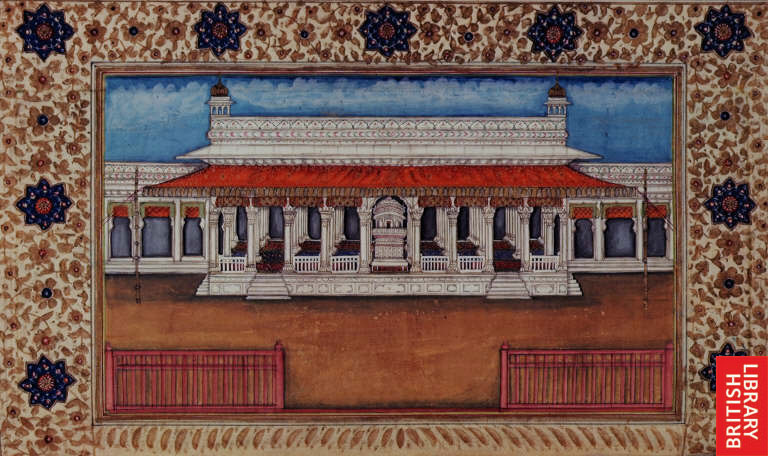
[Artists Impression, 1700s]
Diwan-i-Khas



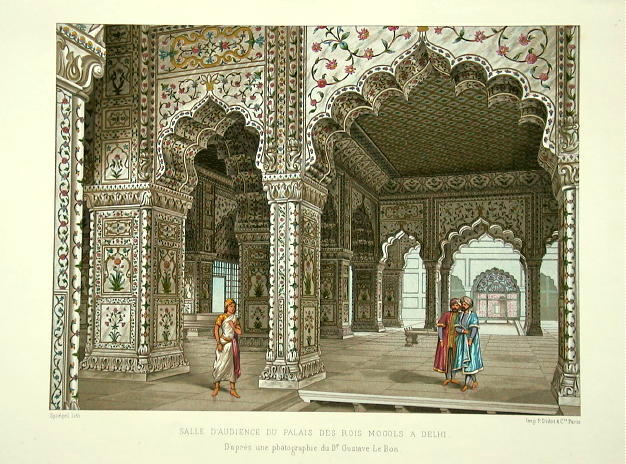
In 1739, Nadir Shah, the Persian emperor, attacked India. He defeated the Mughals and entered Delhi on 20 March. Due to a few skirmishes between the Persian soldiers and locals, Nadir Shah declared the notorious qatl-e-aam of Delhi. On 22 March, he came and sat on the Sunehri Mosque and unsheathed his sword signalling the beginning of the massacre. After six hours, he sheathed his sword when Muhammad Shah, the defeated Mughal Emperor, begged for mercy. It is estimated that 20 to 30 thousand were killed, apart from other atrocities.
The city was sacked for several days. Muhammad Shah handed over the keys to the royal treasury, and lost the Peacock Throne, to Nadir Shah, which thereafter served as a symbol of Persian imperial might. Alongwith a treasure trove of other fabulous jewels, Nadir also gained the Koh-i-Noor and Darya-e-Noor diamonds; they are now part of the British and Iranian Crown Jewels, respectively. Persian troops left Delhi at the beginning of May 1739. Nadir’s soldiers also took with them thousands of elephants, horses and camels that were laden with the booty that they had seized. The plunder seized from India was so rich that Nadir stopped taxation in Iran for a period of three years following his return.


PS :- In 1747, Nader Shah was assassinated by his guards and Persia descended into chaos. The Peacock Throne was chopped to pieces for its gold and jewels. Although the original was lost to history, some experts believe that the legs of the subsequent Iranian Throne, which was also called the Peacock Throne, might have been taken from the Mughal original. The 20th century Pahlavi dynasty in Iran also called their ceremonial seat “the Peacock Throne,” continuing the (pillaging) tradition.
****The End of History as we know it******************


[Rang Mahal]

[Mumtaz Mahal]
As can be seen, there was a series of waterways running under the floor through the entire complex. Cold water was passed through it in summer, hot water in winter and perfumed water every Friday. Vintage air conditioning.
*****Just an aside****
Found a photo from the 1920s of the same portion I had clicked. The intricate marble jaali work seems to be falling apart. So much for restoration work. Also, according to legend, Shah Jahan introduced the symbol of Scales as representing justice. It can be seen clearly in the snap below.
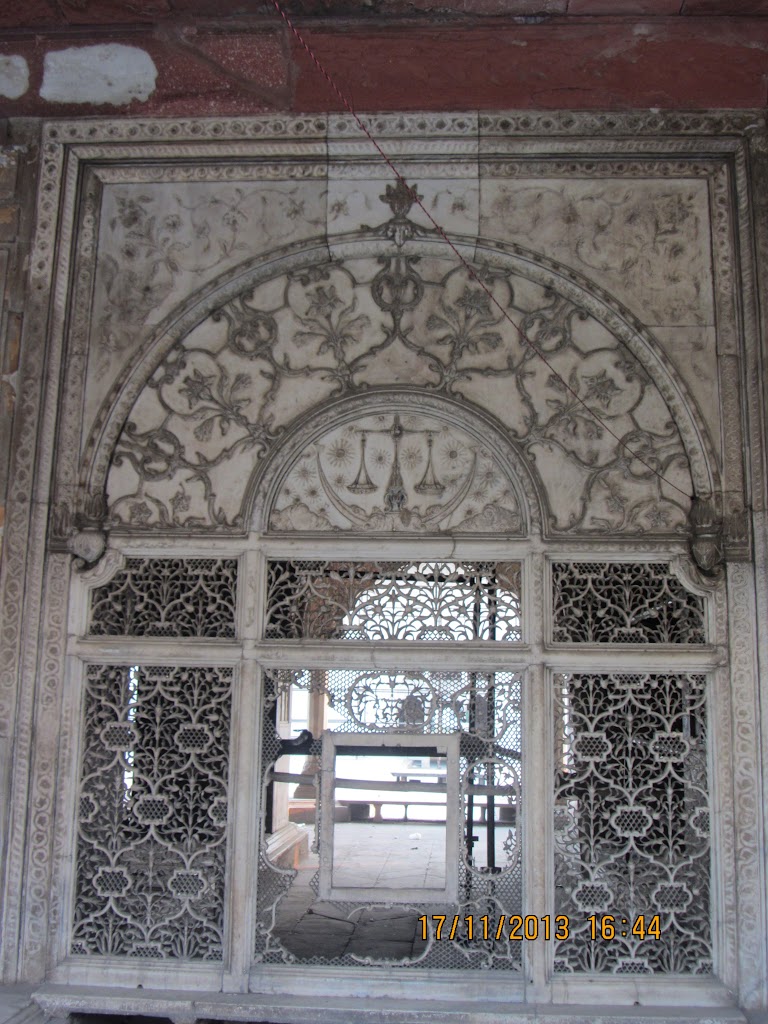
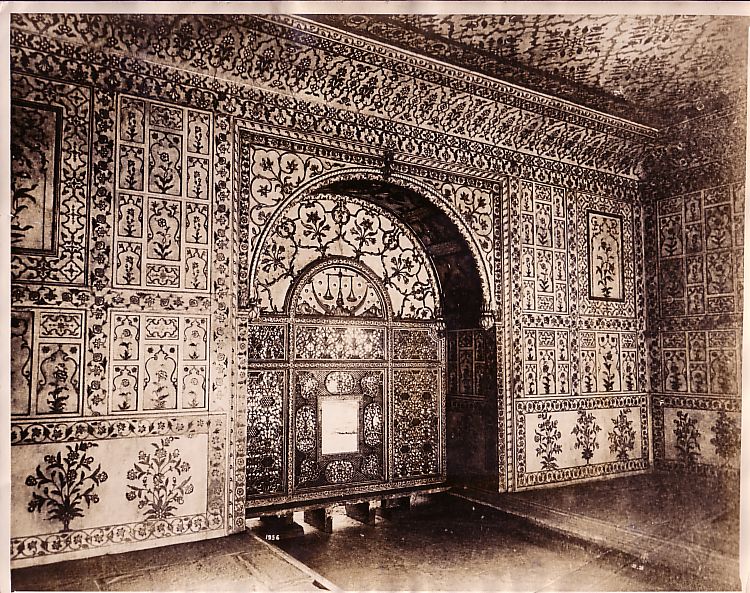
************************************************************
All these mahals are raised on a common marble platform and would have, in the past, provided a view of the flowing Yamuna. According to the guide, the palace rooms below this platform are much more extensive and consists of an entire series of secret pathways to ensure that the Emperors’s exact whereabouts were never known. They also provided a path for the princesses, Jahanara and Roshanara, to reach the Meena Bazaar undetected. All of it is now closed to the public due to security issues.
Moti Masjid
The Moti Masjid is a small marble mosque built by Aurangazeb for his personal use as he preferred to remain within the fort for his personal safety. As per tradition, it is believed that this mosque was paid for by his own earnings. He made skull caps and wrote copies of the Koran and sold it in the Meena bazaar and used the proceeds of these sales for the construction (He must have made an enormous number of them to earn enough for building it………or he sold them at a exorbitant price). From outside, it does not look remarkable.

However, it is supposed to be gorgeous from within. But, the entry to it is prohibited. Putting some photos of it from the net.

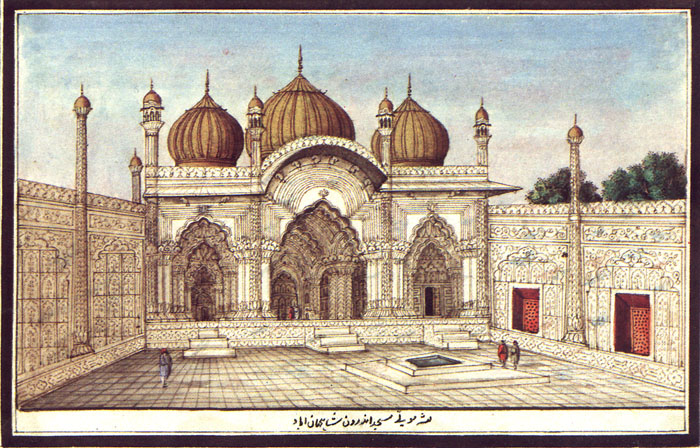
The domes were originally covered in copper. But it was removed and sold by the British.
In fact according to the guide, the entire ground within the fort was covered with makarana marble. After 1857, all the marble was removed and shipped to Calcutta for use in the construction of Victoria Hall.
*******Boring / Interesting History*******
Nadir Shah left a destroyed city and a weakening Mughal empire. The internal weaknesses of the Mughal empire turned Mughals into titular heads of Delhi. A treaty signed in 1752 made Marathas the protector of the throne at Delhi.
The Maratha conquest of Lahore and Peshawar in 1758, put them in direct confrontation with Ahmad Shah Durrani of Afghanistan. In 1760, the Marathas removed and melted the Silver ceiling of the Diwan-i-Khas to generate funds for protecting Delhi from the armies of Ahmed Shah Durrani. In 1761, after the Marathas lost the third battle of Panipat, Delhi was raided by Ahmed Shah Durrani.
(What surprises me is that the Marathi Manoos, at the height of his power, controlled an empire stretching from Thanjavur in the south to Peshawar in the North. In fact, they were in control of Delhi for over 50 years.)
In 1771, Shah Alam ascended to the throne in Delhi with the support of the Marathas.
In 1783, the Sikh, led by Baghel Singh Dhaliwal, conquered Delhi and the Red Fort. The Sikhs agreed to restore Shah Alam as the emperor and retreat from the fort on the condition that Mughals would construct and protect seven historical Gurudwaras in Delhi associated with the Sikh gurus. Sis Ganj Sahib in Chandni Chowk (place where Guru Tegh Bahadur was beheaded) and Rakabganj Sahab near Parliament house (where the Guru was cremated) were built by the Mughals as a part of this deal. (Not sure where the Maratha Manoos was at this time, as he was supposedly still in control of Delhi).
In 1803, during the Second Anglo-Maratha War, the forces of British East India Company defeated the Maratha forces in the Battle of Delhi, ending the Maratha rule over the city and their control over the fort. After the battle, British took over the administration of Mughal territories and installed a Resident at the Mughal courts in Red Fort. The last Mughal emperor to occupy the fort was Bahadur Shah Zafar II, and of course, we know what happened to him.
With the end of the Mughal reign, the British gave official sanctions to remove and sell valuables from the palace at the Red Fort. They put down the harem apartments and instead of them erected a line of barracks.

After independence, it continued to be used as a cantonment and a significant part of the fort remained under the control of the Indian Army. On 22 December 2003, the Army handed it over to the Archaeological Survey of India for restoration.
****The End of History as we know it…finally************
Sawan/ Bhadon Pavilions
This is the last part of the complex which we can still visit. Shah Jahan, it seems, loved the rains. So he had pavilions built with fountains in all sides. He could then sit in them anytime and enjoy the feel of monsoon showers. These pavilions were called Sawan and Bhadon. Of course, the fountains are dry and no longer working.



Conclusion
Finally, it was a good visit. You must take a guide to make sense of the buildings as very little is left of them. In fact, the British army, after 1857, occupied and destroyed many of its pavilions and gardens. A program for restoring the surviving parts of the fort began much later, in 1903. Today, the only structures remaining are those chosen by the British for preservation; the original layout and context of buildings is now lost.
A last bit of advise - avoid weekends. Weekdays are equally crowded but the crowd is decent tourists. On weekends, it is local riffraff which has come to ogle at others. But then, its not that bad either.

[View of Chandni Chowk by night. The Jain Temples and Sis Ganj Gurudwara are visible]
This Sunday we decided to go to old Delhi. After lunch, we took the metro from Dwarka Sec 10, got off at Rajiv Chowk for the yellow line and reached Chandni Chowk around 3. From the station, we took a Rick for Chor Bazaar (30 bucks).
The last time I went to Chor Bazaar was in ‘92. Those days, it was held in the ground in front of Red Fort. It was full of clothes, shoes, books as well as a lot of quirky stuff. You could find old records, gramophones, electronics, antiques, etc. I still remember one old man selling odds and end, including an earthquake intensity measuring equipment.
But in the early 2000s, the venue was shifted further from the Fort, on to the road, probably due to security considerations. In addition, the available space has now been squeezed from behind due to the metro construction. So, it is now a narrow strip, with the metro barricade behind, and a crowded bustling road in front.
**Warning** Once you enter The Strip, be prepared to be pushed, squeezed, jostled, stamped and if you are a lady, groped.
The bazaar is held every sunday. The place is full of clothes, jackets, jeans, suits( yes, formal suits), woollens, blankets, formal shoes, trekking shoes, woodlands, etc.
But no quirky or interesting stuff anymore.



[Don’t miss the Tommy Hilfiger briefs.]
The joy of going to flea market or Chor Bazaar is in leisurely wandering around, hoping to find that one thing you have been searching for, and get it for a steal (pun intended). Or for some, finding that one thing which you never thought of, never needed, have no use for, but still want to buy, the moment you set eyes on it, because it is so quirky and cheap.
Well, all that is no longer possible. The market is probably just reflecting the taste of the general public. Most people nowadays just want to buy clothes and shoes at a bargain - the lower income group in Chor bazaar, middle income group in Big Bazaar and the high income group in Marks & Spencers. All of us, irrespective of how rich we are, are looking for that special sale or great bargain. I guess, the person who may buy an earthquake measuring equipment no longer frequents these bazaars and is just not relevant in the economics of scale any longer.
The only interesting item I saw was a guy selling fish in a bottle…. Filled with yellow colored water and a red flower, for good measure.

After wandering around for some time, we decided to leave as there was nothing interesting.
Red Fort
So we moved on to Red Fort. Again, it was crowded.

There was a long line for tickets, but found a shorter one for ladies on the other side. Lavanya bought the tickets for us. Rs.15 per adult, children upto age 15 free.
***Boring / Interesting History***
[People are either fascinated or bored to death by history. I belong to the former. I never cease to wonder at how today’s India is so different from its past, but is so strongly shaped by it. You can just skip this part if it does not interest you.]
The Red Fort derives its name from the extensive use of red sandstone on the massive walls that surround the fort. Shah Jahan commissioned the construction of the Red Fort in 1638 when he decided to shift his capital from Agra to Delhi. Construction of the fort was completed in 1648. The Red Fort was originally referred to as “Qila-i-Mubarak” (the blessed fort), because it was the residence of the royal family. Unlike the other Mughal forts, layout of the boundary walls of the Red Fort is not symmetrical so as to retain and integrate the older Salimgarh Fort. The Yamuna once flowed along the walls and fed the moats that surround most of the fort wall. It is now 2 km away.
****The End of History as we know it…for now*******
Lahori Gate
There are two main gates leading into the fort. The first is Lahori Gate (leading to Lahore, obviously) and the second, Delhi Gate (Duh). The Delhi gate faced the old Old Delhi while the Lahori Gate faced Chandni Chowk, the Mall Road of Shahjahanabad (now Old Delhi). A third gate, supposedly called Yamuna gate, led to the river, from where the Royal entourage could go by boat to Agra.
****Just an Aside****
Chandni Chowk was designed by Jahanara, Shah Jahan’s daughter, in 1650. It was apparently one of the most beautiful avenues, ever. Foreign visitors describe it as a broad tree lined avenue with clear water flowing through the middle in a canal. There were designer shops on either side. It was named Chandni Chowk after the reflection of moonlight in the water in the canal. Today the 1.4 km stretch of road has a major Mosque, Gurudwara, Hindu Temple, Jain Temple and a Church. The Fatehpuri Mosque, Sis Ganj Gurudwara and Digambar Jain temple are around 350 years old, while the hindu temple is 250 years old and the church is a recent construction - just 200 years old. Where in the world can you find such a heritage?

[View of Chandni Chowk from Lahori Gate, circa 1814-15]
*********************************************************************
We entered the fort through the Lahori Gate, which is the main entrance nowadays. There was a long line, but it moved swiftly. Basically for a normal airport style frisk.
The Independence Day speech by the Prime Minister is given from the ramparts of this gate.


Chatta Chowk
As in most Forts, there was a 90 degree turn as soon as you entered, ostensibly to deny elephants/ battering rams a run up to hit the inner gate. On entering the inner gate, there is a market called the Chatta Chowk or Meena Bazaar. Set up by Jahanara, it was the Harrods of it’s day.

Today, it is a series of small shops selling trinkets, marble figurines and other items of tourist interest. Spoke to a few of the shop keepers. Some have been there for over a 100 years….. and still pay Rs 16 per year as maintenance charges for the premises.
***Mundane Musings***
We took a guide to show us around for Rs 100. I believe, a guide should always be taken when you visit for the first time. He will know the best places to see, how to avoid the crowd and of course a good guide livens up the old dilapidated buildings (as they invariably are in India) with interesting stories attached to them. Some, you can read in guidebooks and internet as they are believed to be true, others you will never hear about as they are part of the storytelling and oral tradition. How much historical truth are there in these stories - your guess is as good as mine. Having a guide with us also highlighted the other age old Indian tradition - of being spectators. See anything happening on the street - an altercation, a fight, an accident, a street show, film shooting - and there will be a big crowd gathered around, doing absolutely nothing, just watching. Don’t think that this is a recent phenomenon. I have read accounts of early British archeologists, and have read references to similar behavior by locals wherever they have dug. So, here too, a crowd would gather around the guide telling the story. The guide would ask them if they would pay and they would give him a blank look or a vacuous smile. In case of him asking somebody repeatedly, he would slowly walk away. The best was a woman who walked in, pushed me aside and stood right in front of the guide. The guide, dripping with sarcasm, asked her if she would at least let him speak to the person paying him. She looked at me, stepped a few inches to the side and with supreme confidence told him to continue the story. But the guide generally let them hear him without demanding payment. As he explained later, he would be getting into a fight everyday if he took them too seriously.
**********************************
Naqqar Khana / Naubat Khana / Drum House
Back to the fort. After the covered bazaar, we enter the open area within the fort. The first building you see is the Naubat Khana or the Welcome room.


[in 1858, after the First War of Independence]
Naubat Khana, it seems, was earlier part of a square enclosure with apartments for the umrah (nobles) on duty. Apart from the Emperor, everyone else had to dismount from their elephants and walk towards the Diwan-i-Am (hall of public audiences) from this point. The premises also housed the court musicians who used to play music for the emperor at designated times. Today, it houses a small, dank and dusty War Memorial Museum on the first floor.

Diwan-i-Aam
On passing through the Naubat Khana, we reached the Diwan-i-Aam, or the Hall of Public Audiences. The Emperor used to listen to public grievances everyday before noon. The hall houses a marble throne, set with precious stones, many of which were looted after the Mutiny of 1857.



[Artists Impression, 1700s]
Diwan-i-Khas
The hall of private audiences is where the Emperor held his private councils. The hall once housed the famous Peacock Throne, studded with rubies and gems, which was taken away by Nadir Shah.




****Boring / Interesting History*******
In 1739, Nadir Shah, the Persian emperor, attacked India. He defeated the Mughals and entered Delhi on 20 March. Due to a few skirmishes between the Persian soldiers and locals, Nadir Shah declared the notorious qatl-e-aam of Delhi. On 22 March, he came and sat on the Sunehri Mosque and unsheathed his sword signalling the beginning of the massacre. After six hours, he sheathed his sword when Muhammad Shah, the defeated Mughal Emperor, begged for mercy. It is estimated that 20 to 30 thousand were killed, apart from other atrocities.
The city was sacked for several days. Muhammad Shah handed over the keys to the royal treasury, and lost the Peacock Throne, to Nadir Shah, which thereafter served as a symbol of Persian imperial might. Alongwith a treasure trove of other fabulous jewels, Nadir also gained the Koh-i-Noor and Darya-e-Noor diamonds; they are now part of the British and Iranian Crown Jewels, respectively. Persian troops left Delhi at the beginning of May 1739. Nadir’s soldiers also took with them thousands of elephants, horses and camels that were laden with the booty that they had seized. The plunder seized from India was so rich that Nadir stopped taxation in Iran for a period of three years following his return.


PS :- In 1747, Nader Shah was assassinated by his guards and Persia descended into chaos. The Peacock Throne was chopped to pieces for its gold and jewels. Although the original was lost to history, some experts believe that the legs of the subsequent Iranian Throne, which was also called the Peacock Throne, might have been taken from the Mughal original. The 20th century Pahlavi dynasty in Iran also called their ceremonial seat “the Peacock Throne,” continuing the (pillaging) tradition.
****The End of History as we know it******************
Palace Complex
This area of the complex also houses a row of white marble structures forming a part of the emperor’s Palace complex. These include the Mumtaz Mahal, Rang Mahal, Khas Mahal, and the Hammam or Royal Baths. Unfortunately, we can no longer enter them as parts of it are falling down.


[Rang Mahal]

[Mumtaz Mahal]
As can be seen, there was a series of waterways running under the floor through the entire complex. Cold water was passed through it in summer, hot water in winter and perfumed water every Friday. Vintage air conditioning.
*****Just an aside****
Found a photo from the 1920s of the same portion I had clicked. The intricate marble jaali work seems to be falling apart. So much for restoration work. Also, according to legend, Shah Jahan introduced the symbol of Scales as representing justice. It can be seen clearly in the snap below.


************************************************************
All these mahals are raised on a common marble platform and would have, in the past, provided a view of the flowing Yamuna. According to the guide, the palace rooms below this platform are much more extensive and consists of an entire series of secret pathways to ensure that the Emperors’s exact whereabouts were never known. They also provided a path for the princesses, Jahanara and Roshanara, to reach the Meena Bazaar undetected. All of it is now closed to the public due to security issues.
Moti Masjid
The Moti Masjid is a small marble mosque built by Aurangazeb for his personal use as he preferred to remain within the fort for his personal safety. As per tradition, it is believed that this mosque was paid for by his own earnings. He made skull caps and wrote copies of the Koran and sold it in the Meena bazaar and used the proceeds of these sales for the construction (He must have made an enormous number of them to earn enough for building it………or he sold them at a exorbitant price). From outside, it does not look remarkable.

However, it is supposed to be gorgeous from within. But, the entry to it is prohibited. Putting some photos of it from the net.


The domes were originally covered in copper. But it was removed and sold by the British.
In fact according to the guide, the entire ground within the fort was covered with makarana marble. After 1857, all the marble was removed and shipped to Calcutta for use in the construction of Victoria Hall.
*******Boring / Interesting History*******
Nadir Shah left a destroyed city and a weakening Mughal empire. The internal weaknesses of the Mughal empire turned Mughals into titular heads of Delhi. A treaty signed in 1752 made Marathas the protector of the throne at Delhi.
The Maratha conquest of Lahore and Peshawar in 1758, put them in direct confrontation with Ahmad Shah Durrani of Afghanistan. In 1760, the Marathas removed and melted the Silver ceiling of the Diwan-i-Khas to generate funds for protecting Delhi from the armies of Ahmed Shah Durrani. In 1761, after the Marathas lost the third battle of Panipat, Delhi was raided by Ahmed Shah Durrani.
(What surprises me is that the Marathi Manoos, at the height of his power, controlled an empire stretching from Thanjavur in the south to Peshawar in the North. In fact, they were in control of Delhi for over 50 years.)
In 1771, Shah Alam ascended to the throne in Delhi with the support of the Marathas.
In 1783, the Sikh, led by Baghel Singh Dhaliwal, conquered Delhi and the Red Fort. The Sikhs agreed to restore Shah Alam as the emperor and retreat from the fort on the condition that Mughals would construct and protect seven historical Gurudwaras in Delhi associated with the Sikh gurus. Sis Ganj Sahib in Chandni Chowk (place where Guru Tegh Bahadur was beheaded) and Rakabganj Sahab near Parliament house (where the Guru was cremated) were built by the Mughals as a part of this deal. (Not sure where the Maratha Manoos was at this time, as he was supposedly still in control of Delhi).
In 1803, during the Second Anglo-Maratha War, the forces of British East India Company defeated the Maratha forces in the Battle of Delhi, ending the Maratha rule over the city and their control over the fort. After the battle, British took over the administration of Mughal territories and installed a Resident at the Mughal courts in Red Fort. The last Mughal emperor to occupy the fort was Bahadur Shah Zafar II, and of course, we know what happened to him.
With the end of the Mughal reign, the British gave official sanctions to remove and sell valuables from the palace at the Red Fort. They put down the harem apartments and instead of them erected a line of barracks.

After independence, it continued to be used as a cantonment and a significant part of the fort remained under the control of the Indian Army. On 22 December 2003, the Army handed it over to the Archaeological Survey of India for restoration.
****The End of History as we know it…finally************
Sawan/ Bhadon Pavilions
This is the last part of the complex which we can still visit. Shah Jahan, it seems, loved the rains. So he had pavilions built with fountains in all sides. He could then sit in them anytime and enjoy the feel of monsoon showers. These pavilions were called Sawan and Bhadon. Of course, the fountains are dry and no longer working.



Conclusion
Finally, it was a good visit. You must take a guide to make sense of the buildings as very little is left of them. In fact, the British army, after 1857, occupied and destroyed many of its pavilions and gardens. A program for restoring the surviving parts of the fort began much later, in 1903. Today, the only structures remaining are those chosen by the British for preservation; the original layout and context of buildings is now lost.
A last bit of advise - avoid weekends. Weekdays are equally crowded but the crowd is decent tourists. On weekends, it is local riffraff which has come to ogle at others. But then, its not that bad either.

[View of Chandni Chowk by night. The Jain Temples and Sis Ganj Gurudwara are visible]









